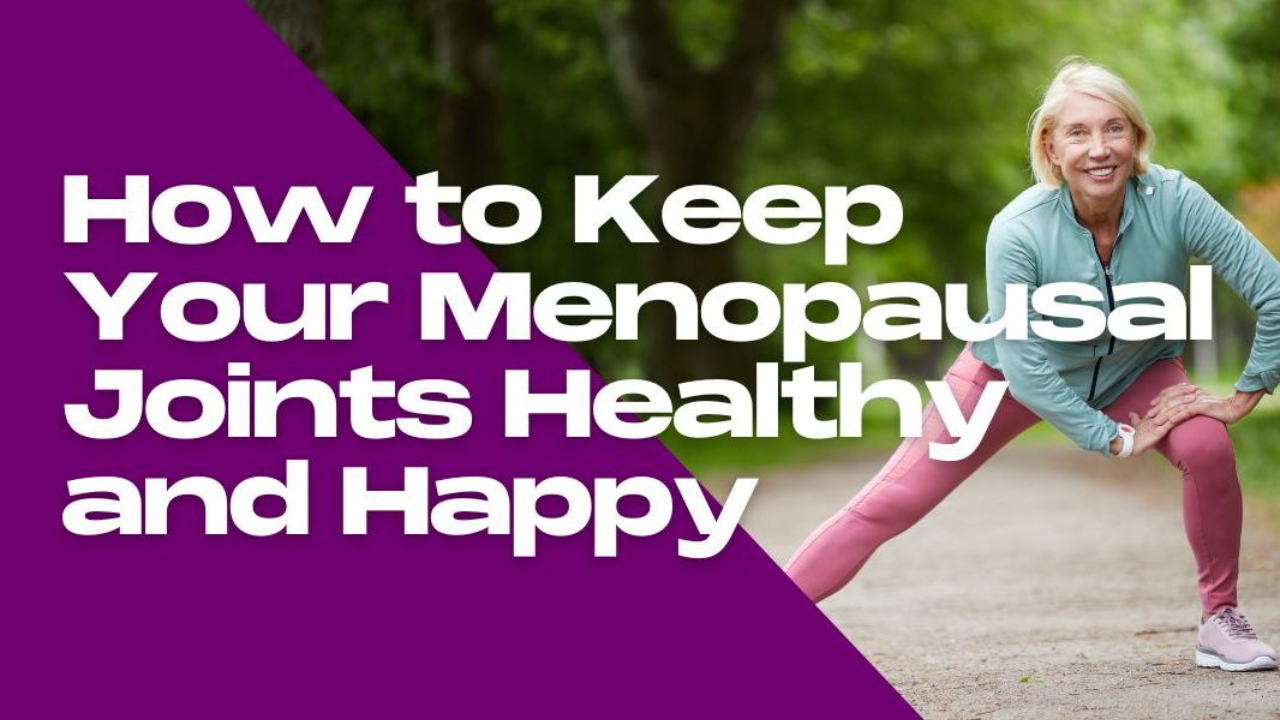
How to Keep Your Menopausal Joints Healthy and Happy
Aug 29, 2023Joint pain can rear its creaky head when you reach the menopause transition. Here’s how to keep moving pain free.
By Selene Yeager
Joint pain is one of those menopausal symptoms that flies under the radar…until you find yourself suddenly sidelined with achy hips, knees, hands, feet, back…or a raging case of “you name it, it hurts.”
By some estimates, twice as many women experience osteoarthritis (OA) and OA pain of any joint as men, and this difference is, as a recent study reported, amplified during menopause.
“LBP [low back pain] prevalence and incidence rates are higher in women than men,” according to the study published in Bone Research. “Moreover, middle-aged women after menopause are more likely to suffer from LBP than their younger counterparts. Similarly, women are more likely to suffer from OA than men, with the prevalence increasing after menopause…Women with severe menopausal symptoms are more likely to suffer from chronic back pain and OA.”
As you’d imagine, there’s a hormonal connection here. “Estrogen has a positive effect on the health of your connective tissues, which includes your ligaments, tendons, and fascia (the thin casing of connective tissue that surrounds your muscles),” explained Claire Callaghan, B.Pty, during Hit Play Not Pause episode 30 Train Smart & Avoid Injury.
Though more research needs to be done, hormone levels appear to have a significant impact on joint, muscle, and connective tissue health, she says. “We often see women presenting with more things like Achilles issues, hip pain, and plantar fasciitis issues in midlife [when estrogen declines].”
Menopausal Joint Health Rx
Obviously, the first stop for any new aches and pains should be a healthcare provider. The caveat here is that most doctors aren’t trained in menopause (a recent survey of OB/GYN residency programs finds that only 31.3% of programs had any type of menopause curriculum in their training…if OB/GYN programs aren’t covering it, you know others aren’t either…). So, they may not consider the menopause connection without you sharing some evidence—like the study cited earlier—with them.
Along with working with a trained professional, here are some strategies that can help.
Investigate Hormone Therapy
If estrogen helps protect the biomechanical structure and function and overall health of your joints, it follows that hormone therapy would help with menopause-related joint pain. Research suggests that may indeed be the case, but findings aren’t yet conclusive and it may take some trial and error.
As noted in the NAMS 2022 Hormone Therapy Position Statement, “there is insufficient evidence to form strong conclusions regarding the effects of estrogen on osteoarthritis.” That’s not to say it doesn’t help. It’s just that some studies have found taking estrogen decreases joint pain in menopausal women; other studies have shown no positive effect (or even an association with more low back pain), and there’s no clear scientifically established association between hormone therapy use and osteoarthritis.
It also may come down to dialing in the right dosage, as well as getting the timing of therapy right. That’s why double-board certified orthopedic surgeon, elite sports doc, and two-time Hit Play Not Pause guest Dr. Vonda Wright recommends seeing an informed doc earlier rather than later. “You do not have to wait until you’re in the throes of hot flashes. Find a practitioner who will help you get the therapy you need in a prescriptive way. Musculoskeletal symptoms of menopause are real!” she says.
Prioritize Strength
Resistance training helps strengthen your muscles, connective tissues, and the bones they attach to. At this point in your life, it’s non-negotiable for health, performance, and mobility, says Callaghan. Though it seems counterintuitive, research shows it can lessen joint pain. A 2020 systematic research review reports that regular strength training improves pain and physical function in knee osteoarthritis.
Just be sure to give yourself a thorough warm up so your joints are properly lubricated and ready to go. (If you’re interested in knowing more about lifting heavy, we have a free guide for that here.)
Eliminate Excess Sugar
Excess sugar has been linked to cardiovascular and metabolic disease. It’s also inflammatory, which is bad news for your body, including those joints, Wright says. In fact, sugar is listed as one of the top foods that can cause inflammation by the Arthritis Foundation, which notes, “The American Journal of Clinical Nutrition warns that processed sugars trigger the release of inflammatory messengers called cytokines. Sugar goes by many names so look out for any word ending in “ose,” e.g., fructose or sucrose on ingredient labels.”
This is something Wright has experienced personally. “When I started feeling perimenopausal was the first time I cut out all white sugar, which was no small thing because I’m a sugar girl. I’d prefer to eat cookies for breakfast. Within three days, I feel so much better. When I’m on sugar, I step out of bed, and I feel creaky and achy and have this short, shuffling gait,” she says.

Make Mobility Your Middle Name
Most of us already appreciate the benefits of a proper warm-up before starting a run, ride, lifting session, or other physical pursuit. But if that’s all you do to prepare your body for your daily activity, it’s kind of like cramming for an exam—it might work sometimes, but it’s stressful and eventually will let you down.
The better approach is making your life more mobility oriented. Sit on the floor when you watch TV. Set an alarm when you’re doing desk work to stand and stretch at least once an hour. Make it a point to take your joints through their full ranges of motion. For that, movement coach and past Hit Play Not Pause guest Petra Fisher recommends a daily dose of “CARS.”
CARS is short for “controlled articular rotation” mobility exercises. They are extremely simple (but can also be challenging if you have limited mobility…the goal is for them to get easier). They are designed to take your joints (especially the rotational ones) through a full range of motion. So circular motions with your shoulders and hips and ankles are part of the plan. These movements are designed to maintain joint lubrication (which decreases during menopause and with age) and range of motion. They also help your muscles access a greater range of motion for better performance. You can find Fisher’s head-to-toe daily routine here.
Consider Joint Health Supplements
Supplements are always a tricky topic because the industry is so poorly regulated. But there is a body of evidence that various joint support supplements such as collagen, glucosamine, eggshell membrane (which contains Type I collagen, glucosamine, chondroitin, and hyaluronic acid), and Boswellia (which is used as an anti-inflammatory) can help support joint health and reduce joint pain.
Two 2022 reviews on collagen peptides, for instance, reported promising results. One found that when paired with resistance training, collagen peptide supplementation can help promote connective tissue recovery, decrease pain, and improve strength and body composition. The other found that collagen-derived peptides may help in the prevention and treatment of tendinopathy (though more research is needed).
Eggshell membrane showed the potential to reduce pain and stiffness in one 2022 randomized clinical trial. Likewise, a 2020 systematic review and meta-analysis showed Boswellia reduced pain and stiffness and improved joint function.
Dosages vary according to each supplement. If you have joint issues/concerns, it can be worth trial and error to find one that works for you. Anecdotally, we hear from many women in our community who swear by these aids to help keep them active and pain and injury free.*
Of course, all of this should complement a generally joint-healthy lifestyle that includes a nutritious diet with plenty of protein, proper rest and recovery, good sleep, stress management, and so forth. All the things that are good for the rest of you are also good for your joint health.
*This is not a paid advertisement, but I’ll note that one of our sponsors Previnex makes a Joint Health Plus product that I’ve found incredibly beneficial. If you are interested in pursuing a supplement you can use our discount code HITPLAY at https://www.previnex.com/ to get 15% off your first order.
Get Feisty 40+ in Your Inbox
We hate SPAM. We will never sell your information, for any reason or send you emails that suck!

